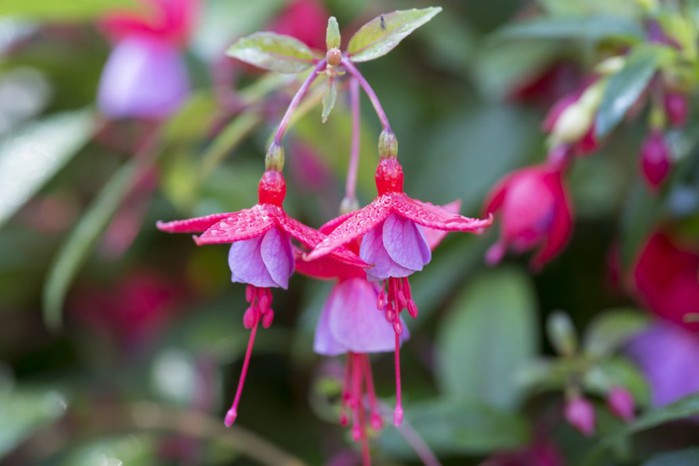
September is a good time to take cuttings of many plants. Some plants, such as half-hardy perennials or tender shrubs, may not make it through the winter, so by taking cuttings you can ensure that you can enjoy them the following year. Taking cuttings in autumn is also a good way of increase your stock of your favourite planting season.
At this time of year, you can take semi-ripe cuttings, from this year’s growth. They are woody at the base and soft at the tip. In autumn, hormone levels are high, so plants should root and grow well. The hard base makes the cuttings less likely to rot.
Watch Monty Don take semi-ripe herb cuttings in this video guide.
Watch as Alan shows the essential kit for taking cuttings.
Discover 10 plants to propagate in September, below.
1
Fuchsia
Both hardy and half-hardy perennial varieties of fuchsia root easily. To produce bushy plants, pinch out the growing tips once rooted, then repeat next spring.
Pink and mauve fuchsia flowers
2
Hebe
Variegated forms of hebe, and varieties with bottlebrush-like flower spikes and narrow leaves, are the most tender, so propagate in case of bad weather.

Bottle-brush like spikes of tiny purple hebe flowers
3
Lavender
Most lavender varieties hate cold and wet winters, but the fashionable compact varieties recommended for containers and French lavender, Lavandula stoechas, are the most at risk; propagate so you don’t lose them.

Lavender flowers beginning to open
4
Penstemon
Penstemon plants winter safely outdoors, but they won’t take severe weather. Older plants tend to become woody and run out of steam – so take cuttings as a ‘belt and braces’ precaution.

Trumpet-shaped magenta penstemons
5
Geranium (pelargonium)
Zonals, regals, miniatures, ivy-leaf and scented-leaf geraniums all root reliably in autumn and it’s cheaper easier than replacing unusual collectors’ kinds. Find out how to take geranium cuttings.

Pink and white pelargoniums
6
Felicia
The kingfisher daisy is a charmer that should be better known, with bright blue daisies that have yellow centres. The scarce variegated form is even better. Take cuttings so you don’t lose your stock.

Blue kingfisher daisies with darker blue lobelia
7
Salvia
Not all salvias are fully hardy and some varieties are hard to come by, so taking cuttings is a good way of keeping your plants going from year to year. Give spare cuttings to friends, so you always know where to beg some back from.

Spikes of orange-red flowers of salvia ‘Blaze of Fire’
8
Lemon verbena
Aloysia citrodora is brilliant for culinary uses and herbal teas, pot pourri and has a fresh lemon flavour. It’s very tender, so needs overwintering as cuttings on a warm windowsill indoors. Find out how to grow lemon balm and lemon verbena.

Picking a sprig of lemon verbena
9
Verbena
Both trailing and upright types of verbena have a low success rate when overwintered in greenhouses. They fare better as rooted cuttings on a windowsill indoors, where it’s warmer.

A close-up of a light-purple verbena flowerhead
10
Helichrysum
A trailing plant, helichrysum is often stiff and ‘leggy’. Take short cuttings in September, then nip out growing tips the following spring. For bushier plants, pinch out for a second time once their sideshoots reach 2.5 – 5cm long.

Silvery buds and tiny, variegated leaves of helichrysum
